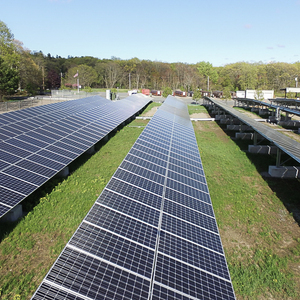
A net-zero global economy is technically and economically possible by the middle of this century. The technologies and business solutions needed to reduce global greenhouse gas emissions to net-zero are already available or close to being brought to market. That is the encouraging conclusion of the latest report, Making Mission Possible, by the Energy Transitions Commission (ETC).
Additionally, creating this net-zero global economy will provide significant social benefits to people all around the world. The transition to a zero-emissions economy will drive innovation and create new jobs. It will improve living standards—particularly in developing economies—through reduced air pollution, cheaper energy bills, higher-quality homes, more flexible mobility services, and more durable consumer goods.
Achievable and affordable
An important basis for the hopeful perspective of the ETC’s findings is that many of the technologies and business solutions needed to reduce greenhouse gas (GHG) emissions to net-zero are already available or close to being brought to market.
Given the time-sensitive nature of the climate crisis, it is therefore essential that we prioritize the immediate deployment, at massive scale, of existing solutions such as solar, wind, batteries, heat pumps, and electric vehicles. Deployment at scale of these existing technologies will further accelerate the innovation, technical improvements, and cost reductions that make these energy solutions of the future more and more competitive.
It is precisely this ongoing improvement in the core technologies of the future energy system that is making the energy transition also affordable. The virtuous cycle of scaling deployments, resulting in technological improvements and lower costs—referred to as the learning curve—has been a consistent phenomenon of the past 30 years.
With the transition spreading around the world, and more investment pouring in, these ongoing improvements are not slowing down. In fact, where in the past we increasingly saw the renewable solutions being the preferred answer for new capacity, they are now becoming commercially viable in replacing the high-carbon energy solutions of the past.
A massive transformation
But the scope, scale, and speed at which the wholesale transformation of our energy system needs to take place is daunting. In its report, the Energy Transition Commission paints a picture of a profound transformation of the global energy system.
Central to this new energy system is clean electrification as the primary route to decarbonization. Electricity could represent up to 70% of final energy demand by 2050, versus only 20% today. Electricity would power mobility and heat our buildings, and even be deployed in certain industrial applications. This will demand a massive ramp-up in clean electricity capacity: we need to multiply by four the size of the electricity system and fully phase out unabated thermal power generation at the same time.
Clean electricity will need to be complemented by large-scale production of hydrogen from clean power. Annual hydrogen production will need to increase from about 60 metric tons today to 500 to 800 metric tons by mid-century to meet the demand for hydrogen, ammonia, and synfuels in end-use applications such as industry and heavy transport. The report also foresees a limited role for sustainable biomass and some fossil fuels combined with carbon capture and storage or use (CCS/U).
To do all of this, the next decade is decisive. We must act now to scale up the deployment of solutions that are market ready, such as wind, solar, heat pumps, and EVs. And we must also invest in getting the remaining decarbonization technologies, such as hydrogen and biofuels, to commercially viable cost and scale. Specifically, the commission recommends that before 2030 governments, corporations, investors, and civil society collaborate to deliver on three priorities:
- Speeding up the deployment of proven zero-carbon solutions, in particular building massive capacities of renewable power generation and massive quantities of heat pumps and EVs
- Creating the right policy and investment environment for the diffusion of low-carbon technologies by removing fossil fuels subsidies, raising carbon prices, and tightening standards and regulations
- Bringing the next wave of zero-carbon technologies for harder-to-abate sectors to market
Regional perspective
Countries around the world can start now by designing their COVID-recovery packages to simultaneously address the immediate health and economic disaster while building for long-term economic recovery around net-zero solutions. By modeling recovery packages on sustainable solutions such as the European Green Deal, countries around the world can build a future that includes improved health, better jobs, lower energy costs, sustained economic growth, and other benefits.
The report concludes that all developed countries are able to reach net-zero emissions by 2050 at the latest, and so can China. Developing nations should be able to meet a growing energy demand and reach net-zero emissions by 2060 but require development finance to de-risk and attract private green investment.
Resource endowments vary significantly by region and country, and so will the optimal path to net-zero. These differing national strategies should inform Nationally Determined Contributions (NDCs) and long-term GHG emissions reduction strategies soon to be submitted to the UNFCCC as part of the Paris Agreement.
As some nations begin to move quickly to be a part of this transition, we are already seeing a global race to the top. For example, China has for nearly a decade led the world in solar manufacturing and has more recently become the world’s largest maker of lithium-ion batteries. The nation now hosts two-thirds of the global manufacturing capacity for both.
With its Green Deal, Europe is setting itself up for a leadership position that will likely translate into a strong competitive position in industries such as EVs, Hydrogen, and Offshore Wind, which has the potential to be worth $1 trillion by 2040. More recently, large-scale hydrogen projects have been announced in Australia, Morocco, Saudi Arabia, and the European Union.
For other nations, this huge shift in economic and industrial calculus seems to be catching some leaders by surprise. Particularly in the United States, in the context of the upcoming election, the future is still somewhat uncertain. Will the next administration continue to bet on the outdated technologies of the past? Or will new insights in Washington DC propel the country forward to become a leader in the energy technologies of the future?
The Commission in its report does not give a perspective. But one sure hopes that the next administration will take the time to understand the implications of the perspective laid out in Making Mission Possible.
-Jules Kortenhorst is CEO of the Rocky Mountain Institute. ©2020 Rocky Mountain Institute. This post originally appeared at RMI Outlet and is republished here with permission.
Weekly Newsletter
Get building science and energy efficiency advice, plus special offers, in your inbox.















14 Comments
This is all too complicated, we will run out of materials and money long before we get to net zero. Smaller homes, LED lighting, highly efficient building envelopes will get the ball rolling cost effectively. Carbon sequestration in soils will help with CO2 levels. Restoring Earth's natural balance must come first.
https://www.carboncycle.org/carbon-farming/
has the field settled on hydrogen generation as the preferred method of energy storage for renewables compared to other options now? Wasn't that contested due to the inefficiency of producing hydrogen to electricity and back again (over 60% loss)? Should we take another look at hydrogen cars vs electric?
"has the field settled on hydrogen generation as the preferred method of energy storage for renewables compared to other options now?"
I don't think so. What has been realized is that in addition to the DUCK curve and the obvious diurnal/nocturnal cycle, there is also the seasonal cycle that is reciprocal in the northern and southern hemisphere. Interruptions in solar PV caused by the DUCK curve and the day/night cycle can be compensated for by large scale use of rechargeable electrical batteries. That really can't be done with seasonal cycles, at least not economically. There is so much difference in sun energy falling on PV in summer versus the winter that it can't be made up without ridiculously overbuilding solar PV.
But there is such an abundance of solar energy in summer in that it is becoming cost effective to overbuild solar PV in PV farms on land that is otherwise not useable. Because of economies of scale when you build large it is not expensive to overbuild enough to produce enough energy to last the entire year just using spring, summer, and fall.
There is a big difference in storing energy for seasonal energy shifting versus storing energy for the DUCK or day/night cycle. Electrical storage batteries are not good at storing energy for long periods of time. Therefore it is better to use chemical storage of hydrogen through electrolysis for long term storage. If you build PV on large enough scales, (again, it would still be a much, much smaller amount than trying to create enough PV just from winter solar gain) it will be cheap enough to overcome the inefficiencies of the electrolysis process. Of course there will also be wind power, geothermal, hydroelectric, and legacy nuclear energy so solar PV won't have to provide ALL the energy in winter. It will be a mix of that and hydrogen being burned in slightly modified existing NG power plants.
Eric, so it sounds like yes, hydrogen generation is the preferred method of long term energy storage from variable rate renewables like wind and solar. For short term day/night cycles batteries may be more efficient, but then again there is a math equation there for the cost of building battery banks vs just using the less efficient hydrogen generators that already need to be in place for seasonal storage. If hydrogen does become the primary source of storage, then all the original arguments for hydrogen cars over EVs seem to make sense again.
Actually, when I said that hydrogen should be burned in modified NG power plants I meant that utility power plants that are now producing electricity by burning NG should switch to hydrogen to make up the solar deficit during winter. I never said, nor do I think, that the inefficiency of ICE cars burning hydrogen can make up for the inefficiency of piston driven engines. Electric cars have high torque from zero rpm, lower maintenance, are quieter, and last longer than ICE cars that burn either hydrocarbons or hydrogen. And we still haven't even discussed the problem of storing hydrogen in automobiles. Hydrogen cars, either with direct combustion or fuel cells, is an idea that has come and gone.
Eric, you misunderstood my comment. The question about hydrogen cars was my own question. I know they are likely dead, it just seems interesting as the main argument I've seen against them is that the hydrogen conversion process is so inefficient (and lack of infrastructure). If we are producing hydrogen anyway though it's a moot point since we will already be producing, transporting, and storing it. Also, the only hydrogen cars I'm aware of are electric cars, they run on a hydrogen fuel cell so all the benefits you listed of electric cars should also be true of hydrogen cars.
Well, I guess it's a matter of perspective but in my state electric cars "aren't just getting started". They're here to stay and the infrastructure is here and scaling with ever increasing adoption. The trajectory of adoption is accelerating and the hydrogen car adoption trajectory here is nonexistent.
Hydrogen in cars is dead because of the low energy density of hydrogen itself and the design requirements for on-vehicle storage. Basically the tanks continuously vent hydrogen to the atmosphere so you could fill a tank on Monday, let the car sit a few days and come back with half a tank or empty.
The question is more about whether hydrogen is the best means for seasonal storage and how much seasonal storage is actually needed. To the degree that the grid relies on wind energy, the seasonal and diurnal factors becomes less important than the weather-related intermittency of the local wind resource. Further, as the overall grid improves capacity to move electricity over long distances, we all get access to more distant wind and solar resources. Clearly, it is a very complicated question. Using excess wind/solar capacity to produce hydrogen and/or synfuels seems like a no-brainer, and the transportation industry loves it because they don't have to change much of anything. But I think in the longer term, smart grid expansion will limit the necessary reliance on hydrogen and its analogs, as will decreasing costs of solar and wind implementation. If I can install cheap enough solar panels on my roof in VT, it doesn't matter if I throw away 80% of my production in summer, so long as I can coast through a week or two of cloudy weather in winter. Then again, if someone is going to pay me for that excess summer production, I'll be happy to sell it.
"Then again, if someone is going to pay me for that excess summer production, I'll be happy to sell it." Isn't that the broader issue with current solar initiatives though? We are giving blanket personal incentives for strategies that may be less efficient or make as much sense for the broader energy grid. Is the whole energy storage and solution really as simple as this article implies-- just build out as much solar+wind as possible and use NG for fluctuations currently, then slowly convert the NG plants to hydrogen? Planes/semitrucks/ships would all run off of hydrogen fuel cells? I thought planes with hydrogen were still in the prototype stage. I keep seeing articles about using complex storage methods that may only work in certain locations (reservoir turbines). A single solution that works in all locations and scales to demand seems like it would be preferable if the numbers support it, or maybe that's just the lazy engineer in me.
I think most of the legacy fossil fuel industry is hoping that hydrogen and hydrogen synfuels will be that single solution, because it means that they can just sort of slide over from fossil to renewable fuels. With hydrogen as the starting point, it's not all that hard to manufacture diesel, jet fuel, or any other hydrocarbon. Of course there are efficiency issues. But hydrogen has some significant engineering challenges with storage and handling, and it's not an energy-dense fuel in terms of BTu/lb. Manufactured methane might be the easiest solution, as our NG infrastructure is already in place. We'll see which technology prevails. But I think the larger point is that, with renewable energy getting cheaper, the idea of overbuilding becomes more attractive. And once overbuilding becomes the norm, then use of energy that would have otherwise been curtailed for manufacture of storable fuels becomes more of a possibility as well. This is all driven by the continuing decrease in cost for renewable energy, and that's the biggest news.
Yes, exactly. Personally I'd love to see the oil companies pay for their transgressions of lobbying and lying about the long term effects of CO2 caused by burning petrochemicals. They all knew about it just like big tobacco knew about smoking and lung cancer. They deserve to go out of business for that reason alone.
The newest electric cars get the equivalent of around 125 mpg using converted energy metrics. They're better cars than there have ever been in quite a few respects. Why hold on to an old technology that is inferior and results in rewarding individuals and companies that knowingly participated in our atmosphere's destruction? Give them all the boot and good riddance.
"The newest electric cars get the equivalent of around 125 mpg using converted energy metrics."
True, but the related economics will change once once government figures out how to charge an equivalent road tax. However, I will be adopting electric-power vehicles once the range/charging time/charging station density/initial purchase price issues are solved
So "clean electrification" is the ultimate solution to our global warming and pollution problems? What about all the other contributors that are not generating electric power currently?
"Additionally, creating this net-zero global economy will provide significant social benefits to people all around the world. The transition to a zero-emissions economy will drive innovation and create new jobs. It will improve living standards—particularly in developing economies—through reduced air pollution, cheaper energy bills, higher-quality homes, more flexible mobility services, and more durable consumer goods." Create enough long-term (not just install solar panels every 10 years) jobs ABOVE the number of people who will be out of work due to fossil fuel closure? Cheaper energy bills for whom (since the major cost to consumers is distribution costs and fees/taxes)? Higher-quality homes (what about the millions of homes now existing that are nowhere near NZE)? More flexible mobility services (mostly mass transit solutions)? This is all just stupidity. There are ways to get to net-zero by 2050 (carbon taxation to reduce demand; institute a national building code standard that requires NZE in all buildings that are over 50 years old; change building plans to only create walkable communities, etc.) but these will ALL require huge expenditures, a complete sea change (culturally) towards real estate valuation and a cultural shift from "big, cheap, quick, lazy = good". With a good portion of the population is unable to afford anything, the rest of the population will make it politically improbably that anything truly significant will be done.
Log in or create an account to post a comment.
Sign up Log in